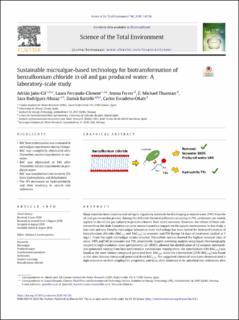| dc.contributor.author | Jaén-Gil, Adrián | |
| dc.contributor.author | Ferrando-Climent, Laura | |
| dc.contributor.author | Ferrer, Imma | |
| dc.contributor.author | Thurman, E. Michael | |
| dc.contributor.author | Rodriguez-Mozaz, Sara | |
| dc.contributor.author | Barceló, Damià | |
| dc.contributor.author | Escudero-Oñate, Carlos | |
| dc.date.accessioned | 2020-09-10T12:44:48Z | |
| dc.date.available | 2020-09-10T12:44:48Z | |
| dc.date.created | 2020-09-09T12:00:37Z | |
| dc.date.issued | 2020 | |
| dc.identifier.citation | Science of the Total Environment. 2020, 748, 141526. | en_US |
| dc.identifier.issn | 0048-9697 | |
| dc.identifier.uri | https://hdl.handle.net/11250/2677277 | |
| dc.description.abstract | Many countries have implemented stringent regulatory standards for discharging produced water (PW) from the oil and gas extraction process. Among the different chemical pollutants occurring in PW, surfactants are widely applied in the oil and gas industry to provide a barrier from metal corrosion. However, the release of these substances from the shale formation can pose serious hazardous impacts on the aquatic environment. In this study, a low-cost and eco-friendly microalgae laboratory-scale technology has been tested for biotransformation of benzalkonium chloride (BACC12 and BACC14) in seawater and PW during 14-days of treatment (spiked at 5 mg/L). From the eight microalgae strains selected, Tetraselmis suecica showed the highest removal rates of about 100% and 54% in seawater and PW, respectively. Suspect screening analysis using liquid chromatography coupled to high-resolution mass spectrometry (LC-HRMS) allowed the identification of 12 isomeric intermediates generated coming from biotransformation mechanisms. Among them, the intermediate [OH-BACC12] was found as the most intense compound generated from BACC12, while the intermediate [2OH-BACC14] was found as the most intense compound generated from BACC14. The suggested chemical structures demonstrated a high reduction on their amphiphilic properties, and thus, their tendency to be adsorbed into sediments after water discharge. In this study, Tetraselmis suecica was classified as the most successful specie to reduce the surfactant activity of benzalkonium chloride in treated effluents. | en_US |
| dc.language.iso | eng | en_US |
| dc.publisher | Elsevier | en_US |
| dc.rights | Navngivelse 4.0 Internasjonal | * |
| dc.rights.uri | http://creativecommons.org/licenses/by/4.0/deed.no | * |
| dc.title | Sustainable microalgae-based technology for biotransformation of benzalkonium chloride in oil and gas produced water: A laboratory-scale study | en_US |
| dc.type | Peer reviewed | en_US |
| dc.type | Journal article | en_US |
| dc.description.version | publishedVersion | en_US |
| dc.source.pagenumber | 12 | en_US |
| dc.source.volume | 748 | en_US |
| dc.source.journal | Science of the Total Environment | en_US |
| dc.identifier.doi | 10.1016/j.scitotenv.2020.141526 | |
| dc.identifier.cristin | 1828362 | |
| cristin.ispublished | true | |
| cristin.fulltext | original | |
| cristin.qualitycode | 2 | |

